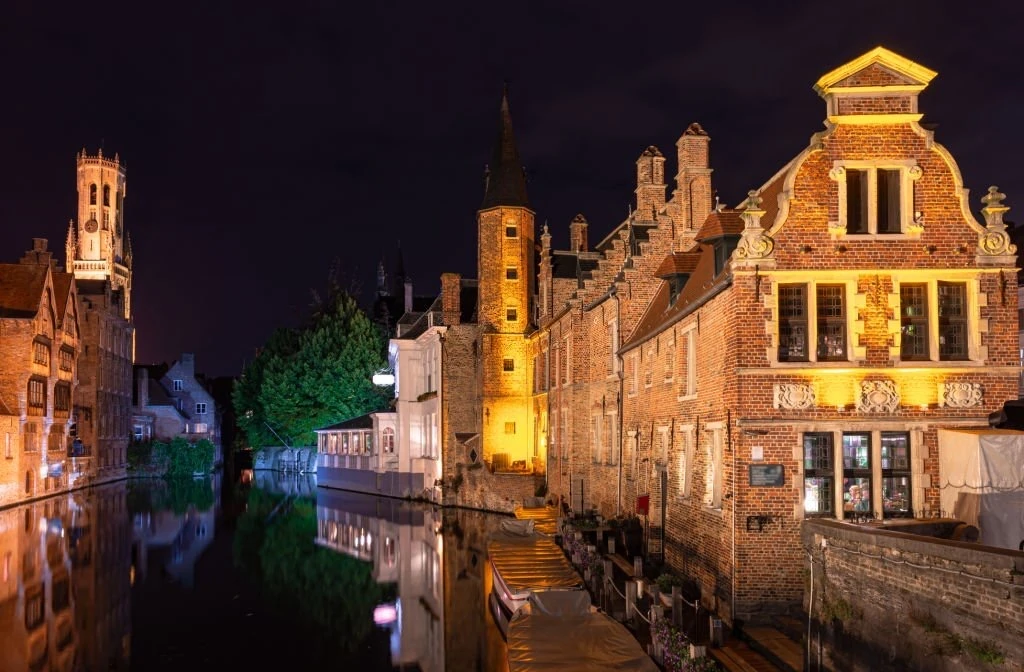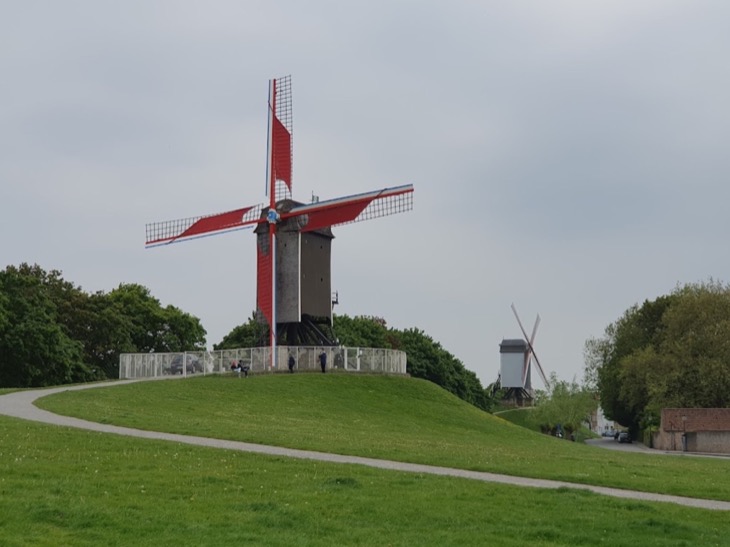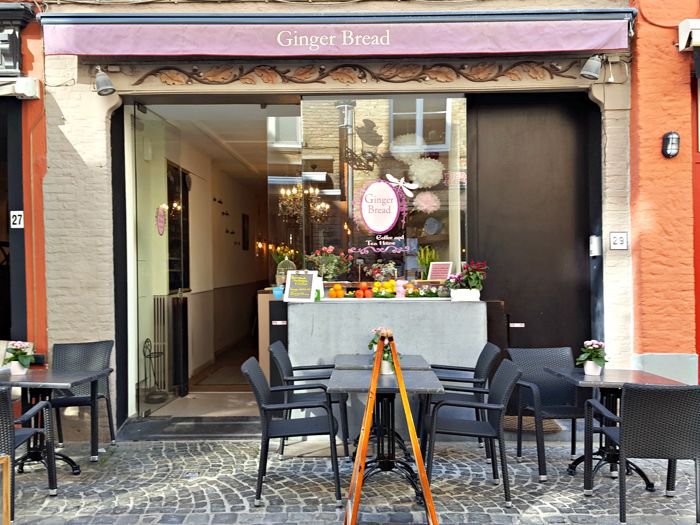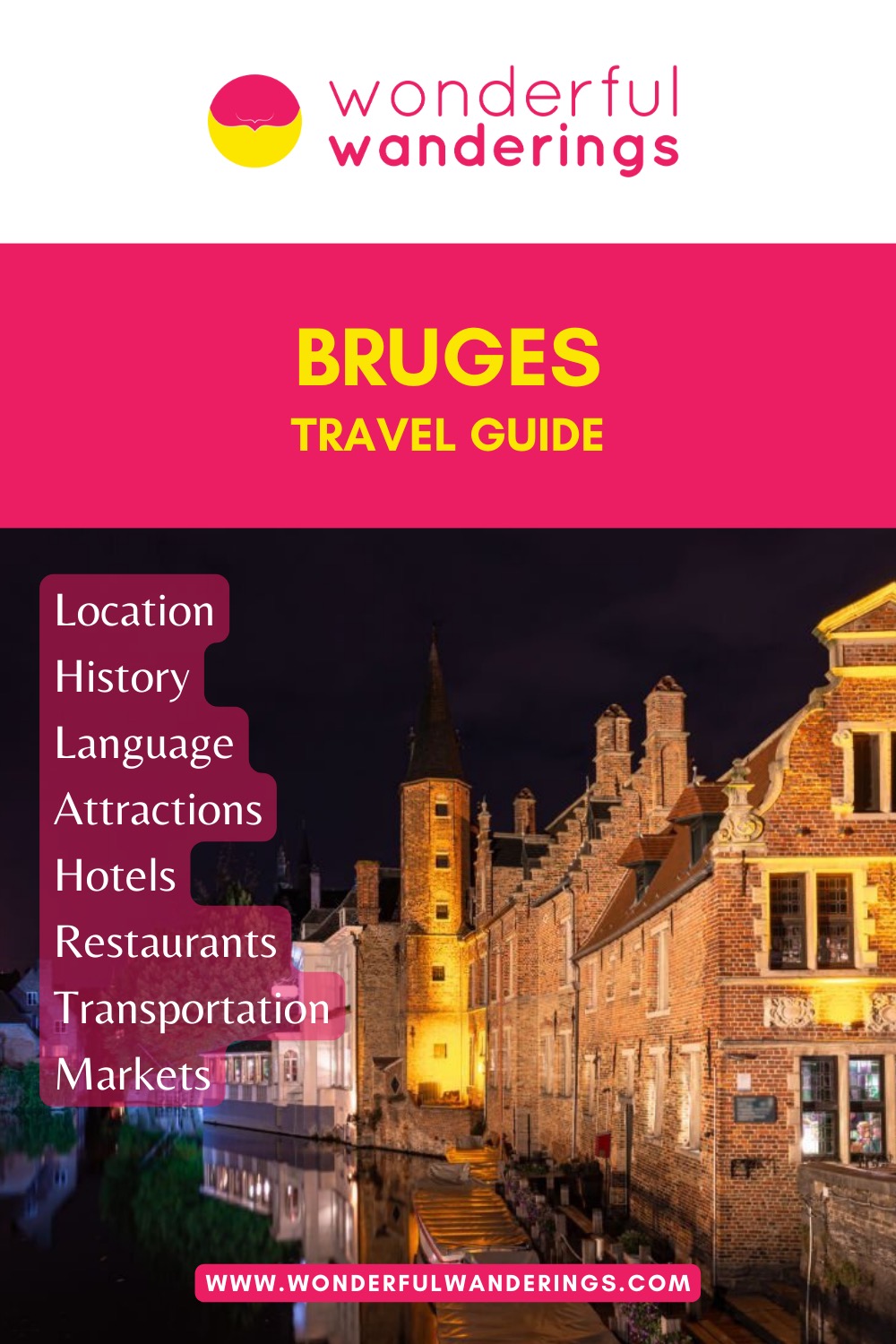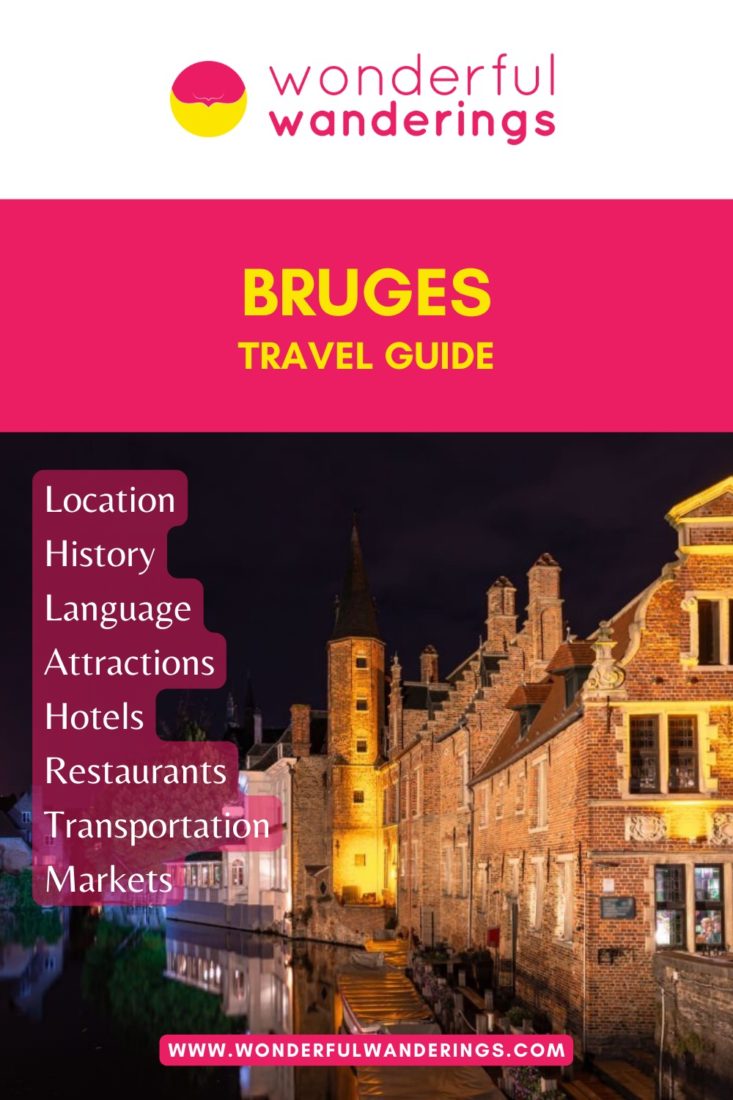Bruges is in northwest Belgium, in the province of West Flanders. It’s near major cities like Brussels and Amsterdam and is 64 kilometers inland from the North Sea. The city has historical significance as a medieval trading hub, particularly in cloth-making and spices. The port and waterways were vital to its growth. Economic decline hit in the 15th century due to waterway silt-up but tourism revived the city in the 19th century. Bruges is now a UNESCO World Heritage Site, famous for its medieval architecture.
Dutch is the main language in Bruges, spoken in a local dialect called West Flemish. The city operates on Central European Time (CET) and observes Daylight Saving Time. As of January 2022, 118,509 people live in Bruges, with a diverse age and ethnic demographic.
Tourists flock to see the preserved medieval center and landmarks like the Belfry Tower. The city gained cultural recognition from the movie “In Bruge”. Activities in Bruges include Market Square visits, canal boat tours and a climb up the Belfry Tower. It’s also home to the Basilica of the Holy Blood and the Church of Our Lady, housing Michelangelo’s “Madonna and Child”.
For a one-day visit, attractions like Musea Sculpta offer a quick but enriching experience. A 2-day stay in Bruges allows visitors to enjoy key attractions like Church of Our Lady, Burg Square and the Begijnhof convent. An extra day permits day trips to nearby places like Damme. Bruges is critical for Belgium tourism. It is a UNESCO World Heritage Site, attracting tourists with its history, lace, chocolates and cultural events. The city’s romantic appeal and historical charm drive tourism in Belgium.
Moules-frites is the most famous dish in Bruges. Other popular foods include Belgian fries, meatballs and Flemish Stew. To get to Bruges, options include train, flight, bus or car. Trains are popular for London travelers. Buses and flights serve longer distances. Bruges Christmas Market is crowded, especially during weekends. It’s part of the larger “Winter Glow” festival, located in the Grote Markt.
Where is Bruges?
Bruges is located in the northwest region of Belgium known as Flanders. It sits about 64 kilometers (40 miles) inland from the North Sea along several canals that connect it to the coastal city of Zeebrugge. Bruges is situated in the province of West Flanders and serves as the capital of the province. The city has an elevation of about 10 feet above sea level.
Geographically, Bruges is situated in northwest Europe. It’s only about 209 kilometers (130 miles) from the United Kingdom and 482 kilometers (300 miles) from Paris. Other major cities near Bruges include Brussels, the capital of Belgium, which is about 96 kilometers (60 miles) to the southeast and Amsterdam in the Netherlands, which is 241 kilometers (150 miles) north. In addition to Flanders, the other main regions of Belgium are Wallonia and the Brussels Capital Region.
Bruges has a geographic location that has historically given it access to the sea via canals and rivers. At the same time, it has a bit of distance and separation from the open ocean, being 64 kilometers (40 miles) inland behind the coastline. This provided it some protection and allowed it to develop into a trading hub during medieval times. The scenic waterways throughout Bruges link it to the North Sea and remain defining features of the city today.
What is the history of Bruges?
Bruges has a long and storied history spanning over a millennium. The origins of the city can be traced back to the 9th century when a fort was built in the area by Baldwin Iron Arm, who was the first Count of Flanders. The fort was constructed amidst marshes and swamps near the convergence of several rivers and the North Sea.
In the 11th and 12th centuries, Bruges grew rapidly as a trading center due to its port which gave it access to the sea. Trade expanded significantly after it was connected to the Zwyn Channel and North Sea via canals. Merchant ships were able to reach Bruges and it became a hub for the Hanseatic League that linked German cities for trading across Northern Europe.
By the 13th century, Bruges had become an important cloth-making town. Local weavers exported fabrics such as wool and linen all over Europe. At the same time, Bruges emerged as the most important market for spices, furs, wine, grain and more. Bruges’ docks hosted ships from across the continent. Wealthy foreign merchants and bankers set up operations in Bruges, financing trade and the city’s rulers.
Bruges continued to thrive economically and culturally over the next two centuries. Many of its iconic medieval buildings and landmarks were constructed during this prosperous Golden Age. However, by the 15th century, the city’s main waterway to the sea began to silt up. This stifled shipping and led to Bruges’ gradual economic decline, especially as the center of global trade shifted.
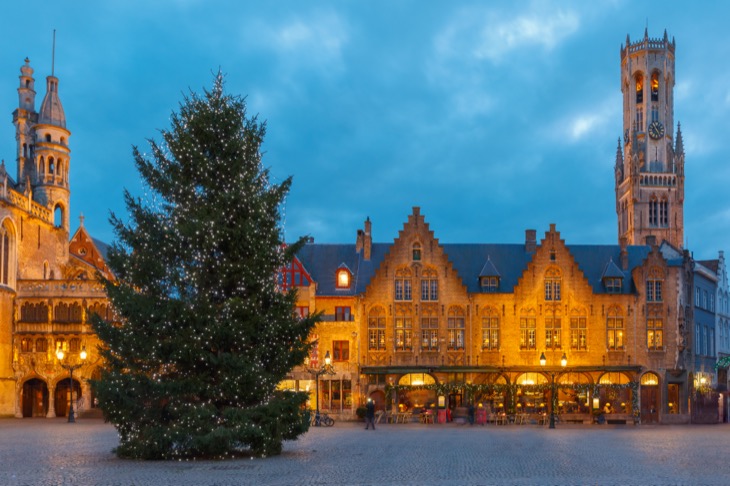
Bruges during Christmas
Over the centuries that followed, Bruges’ significance diminished. But the fact that it didn’t develop further left its medieval core remarkably intact. In the 19th century, tourism started to grow as people appreciated Bruges’ quaint ambience and historic architecture. Preservation efforts began, eventually leading to it becoming a UNESCO site. Today it remains a famous tourist destination attracting millions annually.
What language is spoken in Bruges?
In Bruges, Dutch is the primary language spoken. This reflects Bruge’s location in the northern Dutch-speaking region of Flanders in Belgium. Dutch is the language most commonly heard on the streets and used daily. Specifically, the local dialect is West Flemish, which has some distinctions from the standard Dutch spoken in the Netherlands. West Flemish developed out of the Old Frankish dialects originally spoken in Flanders. It uses some unique vocabulary and expressions that differ from standard Dutch. The streets of Bruges prominently echo the West Flemish dialect of Dutch, reminding visitors they are in the historic Flanders region where the Dutch language first emerged. The old Flemish identity remains at the heart of Bruges despite Belgium’s internal divisions.
What timezone is Bruges on?
Bruges and all of Belgium are on Central European Time (CET). It is 1 hour ahead of Greenwich Mean Time or UTC+1. CET is used throughout the winter in Bruges. As Belgium observes Daylight Saving Time, clocks move forward 1 hour to Central European Summer Time (CEST) on the last Sunday of March. CEST is UTC+2 and will continue in Bruges until the last Sunday of October. The time zone used in Bruges and Belgium is consistent with most of Western Europe. Neighbouring countries like France, Germany, Netherlands and Luxembourg are also on CET/CEST. Bruge’s position in the middle of Western Europe means it has midday, around 11am GMT in winter or 12pm GMT during summer daylight saving time. For those calling Bruges from North America, the time difference ranges from 6 hours behind Eastern Standard Time to 9 hours behind Pacific Standard Time, depending on daylight saving adjustments. In practice, time zone usage in Bruges creates little confusion as devices like smartphones, computers and digital clocks will automatically update for daylight saving.
How many people live in Bruges?
Bruges has a total population of 118,509 people as of 1st January 2022. It is the largest city in Belgium’s West Flanders province. 48.8% of this Bruges’ population are male and 52.2% are female. The population comprises 24.7% of people aged 65 years or older while 59% are aged between 18-64 years. Young people under 18 make up 16.3% of the population. Bruge’s wider metropolitan area covers the nearby municipalities of Dudzele, Damme, Lissewege and ZeeBruges, bringing the total population to 118,509. The majority of Bruge’s residents are native Flemish speakers. There is also a sizable immigrant community, with the largest groups coming from the Netherlands, France, the United Kingdom, Poland, Spain and the Middle East. As an important tourist destination, Bruges sees its population swell significantly during the summer high season. The influx of visitors and tourists can nearly double the city’s headcount. Bruges is densely populated at 856.3 people per square kilometre.
What are the most interesting facts of Bruges?
Listed below are the most interesting facts about Bruges:
- Bruges Currency: Bruges uses the Euro (€) as its official currency, as a part of Belgium and Europe. The Euro’s stability and prominence on the global stage reflect the region’s economic strength.
- Timezone of Bruges: Bruges is in the Central European Time (CET) zone, one hour ahead of Greenwich Mean Time (UTC+1). Bruges observes Daylight Saving Time during the summer, shifting to Central European Summer Time (CEST), UTC+2.
- Language Spoken in Bruges: The main language spoken in Bruges is Dutch. French is also used occasionally.
- Power Plugs Used in Bruges: In Bruges (and Belgium), the power plug sockets are of type E. The standard voltage is 230 V and the standard frequency is 50 Hz. Travellers to Bruges should ensure their devices are compatible with this plug or carry the necessary adapters. The uniformity of power plugs and sockets across Belgium, including Bruges, demonstrates the country’s commitment to standardisation and modernisation, aligning with the broader European standards. Like many others, this fact contributes to the ease of travel and business within Bruges and the facts of Belgium’s integration with the rest of Europe.
What is Bruges famous for?
Bruges is most famous for its exceptionally well-preserved medieval town center. The entire historic core of Bruges was named a UNESCO World Heritage Site in 2000. Many government and civic efforts have helped maintain the authentic ambience of the city’s medieval architecture and layout over centuries. When visiting Bruges, tourists are transported back in time to the Middle Ages as they stroll along picturesque canals, view intricate gothic buildings and experience landmarks like the iconic belfry tower. The market squares also showcase Bruges’ medieval roots. This Old World atmosphere and charm makes Bruges a top destination for travelers.
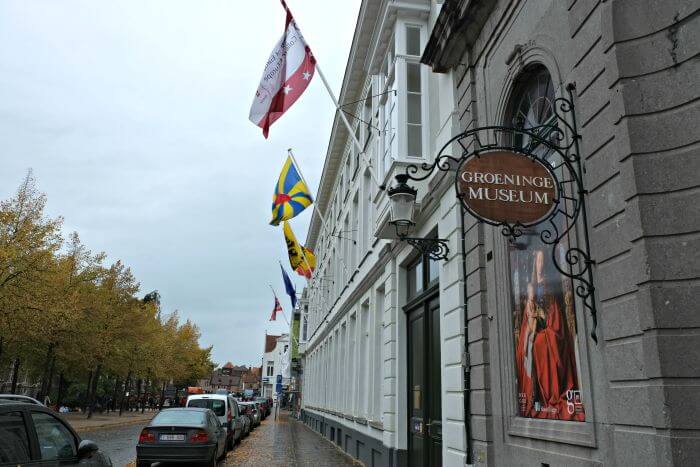
The Groeningemuseum
Bruges gained popularity due to the black crime/comedy movie “In Bruge”, starring actors Colin Farrell and Brendan Gleeson. The “In Bruge” filming locations are freely accessible; most were already popular before the film was shot. The Minnewater Bridge, where Harry arrives in the city in the movie, is associated with a local legend and is said to ensure eternal love for couples who cross it. The Relais Bourgondisch Cruyce Hotel, where Ray and Ken are forced to share a room, is located by a corner of Rozenhoedkaai, possibly the most photographed place in Bruges. As depicted in the film, Rozenhoedkaai is also one of the embarkation points for the popular canal tours in Bruges. The Bruges Market Square, the Belfry and the Breidelstraat are significant locations, with the Belfry being a UNESCO World Heritage site. ‘t Zwart Huis or “The Black House,” is the bistro where Ray and Ken taste their first Belgian beer. The Basilica of the Holy Blood is glimpsed when Harry is chasing Ray at the movie’s end. The film’s locations can be explored through an “In Bruge” walking tour, marked on a handy map provided by the tourism office of Bruges. The facts and locations related to the movie “In Bruge” have become an integral part of the city’s cultural identity and visitors can relive scenes from Bruge’s filming locations by visiting them.
What are the best things to do in Bruges?
Find below are the best things to do in Bruges:
- Market Square (Markt). Market Square is a historic open square and vibrant center of Bruges for over a thousand years. It hosts a bustling weekly market selling local produce, cheeses, meats and handmade goods. The square is surrounded by magnificent medieval buildings like the Belfry tower, Provincial Court and colorful gabled guildhouses.
- Canal boat tour. The canal boat tour explores Bruges’ picturesque waterways and landmarks. It passes sites like the Belfry, Church of Our Lady, Beguinage and picturesque buildings along Rozenhoedkaai. Live commentary provides history about Bruges’ canals. Tours run daily on open-top boats holding about 40 passengers.
- Belfry Tower (Belfort). The Belfry Tower is a 83 meter tall 13th century Gothic bell tower looming over Bruges’ Markt square. Its carillon bells historically regulated daily life. Visitors can climb 366 steps to reach the observation deck for panoramic views over Bruges.
- Basilica of the Holy Blood. The Basilica of the Holy Blood is a Roman Catholic minor basilica. It houses a revered relic, said to be cloth with Christ’s blood collected after the crucifixion. The Romanesque and Gothic style basilica was built in the 12th century as a chapel for the Count of Flanders.
- Rozenhoedkaai (Quay of the Rosary). Rozenhoedkaai is a picturesque canal offering amazing views of Bruges’ medieval architecture and the iconic Belfry tower. With its colorful buildings reflected in the calm waters, it is considered one of Bruges’ most photographed spots.
- Church of Our Lady (Onze-Lieve-Vrouwekerk). The Church of Our Lady is a 13th-15th century Gothic church renowned for its 115 meter high brick tower dominating Bruges’ skyline. Inside is Michelangelo’s famous sculpture “Madonna and Child”.
What to do in Bruges for a day?
Listed below is what to do in Bruges for a day:
- Musea Sculpta: Musea Sculpta is a must-visit for art enthusiasts spending a day in Bruges. This unique museum showcases intricate sculptures carved from blocks of ice and sand. The detailed craftsmanship and creativity on display provide a one-of-a-kind visual experience. Whether admiring the frozen beauty of ice sculptures or the transient artistry of sand creations, Musea Sculpta offers a fascinating glimpse into unconventional art forms. The museum is small and can be easily visited within a hours, which is ideal for one day visit in Bruges.
- Minnewater (Lake of Love): The Lovers’ Bridge and Lake of Love is an ideal place to visit in Bruges for a day. This romantic spot is perfect for a stroll or a peaceful moment by the water. The legend of eternal love associated with the bridge adds a touch of magic to the experience. Whether visiting with a loved one or simply enjoying the natural beauty, the Lovers’ Bridge and Lake of Love are essential stops in a 24-hour visit to Bruges.
- Canal boat tour. The canal boat tour explores Bruges’ picturesque waterways and landmarks. It passes sites like the Belfry, Church of Our Lady, Beguinage and picturesque buildings along Rozenhoedkaai. Live commentary provides history about Bruges’ canals. Tours run daily on open-top boats holding about 40 passengers. A canal boat tour is definitely recommended to do in Bruges when people have limited time, as visitors can explore many Bruges’ attractions by the sea.
What is the ideal visit duration for a Bruges visit?
The ideal visit duration for a Bruges visit is 2 days. However, there are several factors to take into account. Bruges is a small city packed with charming architecture, museums, restaurants and canals. Two days are enough time to stroll around and take in the romantic atmosphere without feeling rushed. It allows one to see sites such as the Church of Our Lady, Burg Square and the Begijnhof convent. A visitor can take a relaxing canal boat tour and have time to visit some of Bruge’s excellent museums like the Groeningemuseum or Choco-Story. With two days, there’s time to sample delicious Belgian beers and chocolate and enjoy a meal at one of Bruge’s many cosy restaurants. The city has a magical atmosphere in the evenings when it’s lit up. Adding a third day opens up opportunities for some day trips from Bruges. One could visit the nearby Damme, take a bike ride to the windmills or head to the coast. However, for most visitors focused just on Bruges, two days provides the ideal amount of time to enjoy the city comfortably. When planning the ideal visit duration for Bruges, two full days allow visitors to experience the charm of this beautiful city without feeling rushed.
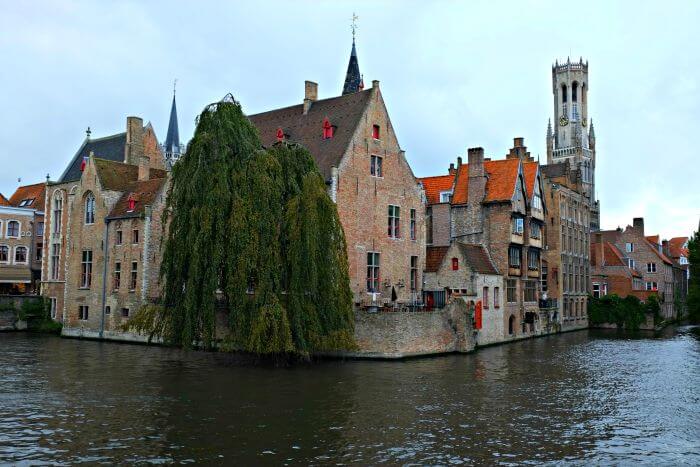
Relais Bourgondisch Cruyce
What is Bruges City’s contribution to Belgium tourism?
Bruges City’s contribution to Belgium tourism is significant. As one of Europe’s best-preserved cities, Bruges is a place that lives and breathes history, offering a journey back to the Middle Ages. The historic city centre has been designated a UNESCO World Heritage Site and its iconic spires, beautiful streets and winding canals create a beautiful setting that attracts tourists worldwide. The city is also popular for its famous lace, chocolates and culinary culture, adding to its appeal as a destination. Annual events such as the Procession of the Holy Blood and the masterpieces of the Flemish Primitives at the Groeningemuseum further enrich the cultural experience. Bruge’s reputation as the “unofficial capital of romance” and its status as a picture-perfect destination have endured for hundreds of years, making it an ideal destination for romantic getaways. The city’s unique blend of history, art and romance is vital in attracting tourists to Belgium, enhancing the country’s overall appeal as a travel destination.
What are the best hotels and neighbourhoods to stay in Bruges?
Listed below are the best hotels in Bruges.
- Relais Bourgondisch Cruyce: Relais Bourgondisch Cruyce is a 4-star hotel known for its luxurious ambiance and beautiful canal views. With its timber-framed face and elegantly furnished rooms, the hotel offers a blend of historical charm and modern comfort. Guests can enjoy easy access to major attractions and indulge in fine dining at the hotel’s acclaimed restaurant.
- Hotel van Cleef: Hotel van Cleef is a boutique hotel that stands out as one of the best hotels in Bruges. Offering a sophisticated and stylish setting, the hotel features spacious rooms with chic décor and high-end amenities. The hotel’s terrace overlooking the canal provides a serene spot for relaxation and its central location makes it an ideal base for exploring the city.
- Dukes’ Academie: Dukes’ Academie is a refined hotel near Bruge’s historic centre. The hotel’s elegant design and top-notch service ensure a memorable stay for its guests. With its spacious rooms, beautiful garden and proximity to key attractions, Dukes’ Academie offers luxury and convenience for travellers seeking a high-quality accommodation experience.
- The Pand Hotel – Small Luxury Hotels of The World: The Pand Hotel, part of the Small Luxury Hotels of The World collection, is among the best hotels in Bruges. Known for its personalised services and attention to detail, the hotel offers luxurious rooms decorated with antiques and fine fabrics. Guests can enjoy a sumptuous breakfast in the hotel’s intimate dining room and take advantage of its prime location near the city’s main sights.
Bruges has several neighbourhoods that offer different experiences for tourists. The Steenstraat Quarter is central and lively, featuring historic landmarks like the Belfort belfry tower and a variety of shopping and dining options. Burg Quarter is another tourist hub, home to the Bruges City Hall and the Basilica of the Holy Blood. Magdalena Quarter offers a quieter, residential feel with medieval charm and a well-known fish market. Sint-Gillis Quarter is also quiet but rich in medieval architecture, including a Gothic-style church. Ezelstraat Quarter has a youthful vibe due to a college campus and offers trendy dining and shopping. Onze-Lieve-Vrouw Quarter is busy and central, with landmarks like the Church of Our Lady and the Groeningemuseum. Hotel prices vary, but all areas are considered safe for tourists.
What are the top restaurants in Bruges?
Listed below are the top restaurants to eat and drink in Bruges:
- Bartholomeus: Bartholomeus is a popular restaurant in Bruges, offering a fine dining experience focusing on seafood. The restaurant’s innovative menu, crafted by Chef Bart Desmidt, combines fresh local ingredients with creative culinary techniques. With its elegant ambience and impeccable service, Bartholomeus is a top choice for those seeking a memorable meal in Bruges.
- Bij Koen & Marijke – In’t Nieuw Museum: Bij Koen & Marijke – In’t Nieuw Museum is among the best places to eat and drink in Bruges. This family-run restaurant offers a warm and welcoming atmosphere, serving traditional Belgian cuisine with a modern twist. Whether enjoying lunch, dinner or making reservations for a special occasion, guests can eat hearty dishes prepared with love and attention to detail.
- Bistro Bruut: Bistro Bruut stands out among the best restaurants to eat in Bruges, known for its innovative and seasonal menu. Chef Bruno Timperman creates dishes that are both visually beautiful and full of flavour, using locally sourced ingredients. The restaurant’s chic and minimalist décor complements the culinary experience, making Bistro Bruut a must-visit destination for food enthusiasts seeking a unique dining experience in Bruges.
What local food is popular to eat in Bruges?
Moules-frites is the most popular food to eat in Bruges. The classic Belgian dish of mussels, known as Moules-frites, is commonly steamed in white wine with ingredients like shallots and parsley, often paired with the nation’s pride, Belgian fries. These distinctively double-fried fries offer a soft inside and crispy exterior, best enjoyed from genuine “friteries” or “frietkots,” and are often accompanied by various mayonnaise-based sauces. Meatballs, a favourite in Belgium, vary by region and are typically paired with crispy Belgian fries. Flemish Stew or Carbonnade à la flamande, is a comforting beef stew slow-cooked in Belgian beer, often paired with fries or mashed potatoes. Belgium’s North Sea grey shrimps, a cultural heritage, are often enjoyed in croquette form and the country’s synonymous waffles come in two main types: the rectangular Brussels waffle and the sweeter Liège waffle. These dishes offer a taste of Bruges and provide a glimpse into the typical food in Belgium.
What are the best cafes in Bruges?
Listed below are the best cafes in Bruges:
- Li O Lait. Li O Lait is a popular coffee bar known for its wide selection of coffee and tea drinks prepared by trained baristas. It is located in Bruges, Belgium and has signature iced drinks like Li-O-Nade flavored lemonades. Li O Lait also has an extensive food menu with items like bagels, quiches and pastries.
- Kottee Kaffee. Kottee Kaffee is a cozy coffeehouse located in the historic center of Bruges, Belgium. It offers specialty coffees, teas and freshly baked breads, including gluten-free options. Kottee Kaffee is situated just a few minutes walk from Market Square.
- Tonka Tearoom. Tonka Tearoom is a charming tearoom in the heart of Bruges known for its homemade tonka bean hot chocolate. It also serves teas, coffees, waffles and light lunches in a relaxing atmosphere with views of the scenic canals.
- Cafe ‘t Klein Venetië. Cafe ‘t Klein Venetië is a cozy cafe with scenic outdoor seating overlooking the landmark Belfry Tower and canal in Bruges. It is known for draft beers, simple Belgian fare and friendly service staff.
How to get to Bruges?
There are four ways to get to Bruges depending on the location. Firstly, by train if one is travelling from London. The Eurostar offers a convenient and comfortable route from London to Bruges, with a journey time of 3 hours and 25 minutes. Secondly, by flight. Although Bruges itself does not have an airport, one can fly into nearby airports such as Brussels Airport (Zaventem) or Brussels South Charleroi Airport. From there, one can take a train or other ground transportation to reach Bruges. Thirdly, by bus. Buses are available for travel to Bruges from various European cities. One can check bus routes and schedules for options that suit one’s location. Lastly, by car. If travellers prefer driving, one can rent a car and reach Bruges by road, depending on the location. The city is well-connected to major highways.
The choice of transportation depends on one’s location and preferences. Trains are a popular choice for travellers coming from London, while flights and buses offer options for longer-distance travel.
How to get from Bruges to Brussels?
- Firstly, determine the mode of transport. The traveller must decide on the mode of transport that best suits their preferences, budget and schedule. Options include train, car or bus. Each mode offers different advantages in speed, comfort and cost.
- Secondly, head to Bruge’s main train station (if taking the train). The traveller should head to Bruge’s main train station if opting for the train. Trains run frequently between Bruges and Brussels, with standard and high-speed options available. The station is well-connected to the city, with local buses and taxis providing easy access.
- Thirdly, purchase a ticket to Brussels. Tickets can be purchased online in advance or at the ticket counter in the station. Online booking may offer discounts and the convenience of e-tickets. At the station, ticket machines and staffed counters are available to assist with purchases.
- Fourthly, board the train to Brussels. The traveller should check the departure boards for the platform number and board the train to Brussels. The journey usually takes around one hour, depending on the type of train and offers scenic views of the Belgian countryside.
- Fifthly, drive to Brussels (if choosing to drive). If the traveller opts to drive, they can rent a car or use their own vehicle. The E40 motorway directly connects Bruges to Brussels and the drive is straightforward with clear signage. Travellers should be aware of traffic conditions and any tolls along the route.
- Sixthly, take a bus to Brussels (if choosing the bus). Coach services like FlixBus operate between Bruges and Brussels. Booking can be done online or at the station and the buses are equipped with amenities like Wi-Fi and power outlets. The journey by bus may take longer but can be a cost-effective option.
- Seventhly, ensure necessary documents are ready. Regardless of the mode of transport, travellers should have all necessary documents, such as tickets, driving licences or identification, readily available. This ensures a smooth and hassle-free journey.
- Eighthly, utilise local transportation in Brussels. Upon arrival in Brussels, local transportation options like trams, buses or taxis are available to reach specific destinations within the city. Public transport is well-organised and maps or apps can assist with navigation.
Are Christmas markets crowded in Bruges?
Bruges Christmas Market does get quite crowded, especially on weekends, holidays and peak times. Proper planning and visiting during off-peak times could help mitigate the crowds. Since Bruges is a popular tourist destination, its Christmas market attracts many visitors each year. The Bruges Christmas Market is an annual event that takes place in the city of Bruges, Belgium. It is part of a larger winter festival called “Winter Glow”, which includes festive lighting displays, an ice skating rink and other holiday attractions around the city. The main Christmas market is located in the Grote Markt, the central square of Bruges’ historic district. The Grote Markt is surrounded by the Belfry of Bruges, the Provincial Palace and picturesque medieval buildings. Over 130 market stall chalets are set up, suggesting a sizable area is needed to accommodate them and all the visitors. The market offers a festive atmosphere with lights, music, events, food stalls, etc. which are all big draws for crowds.
Are there any festivals during Christmas in Bruges?
Yes, there are several Christmas festivals in Bruges. Bruges is a magical place to visit during the Christmas season, with charming decorations, festive cheer and some special events and festivals taking place. Several festivals help celebrate Christmas in Bruges and add to the city’s enchanting atmosphere. One of the highlights is the Snow & Ice Sculpture Festival, which takes place annually in December. This unique festival showcases snow and ice sculptures around the city centre and at Minnewater Park. It’s a stunning sight, with the icy sculptures glowing at night. Bruges also hosts a December Winter Glow festival, lighting up historic buildings and bridges with colourful illuminations. Key landmarks like the Church of Our Lady, the Belfry and St. Salvator’s Cathedral glow against the night sky. It creates a magical experience walking Bruge’s streets. The centre is home to cheerful Christmas markets selling gifts, food and drink in the weeks before Christmas. The sound of Christmas carols fills the air. The historic Grote Markt is particularly beautiful, with an ice rink and a towering Christmas tree. The churches in Bruges also hold special masses and concerts in the lead-up to Christmas, showcasing the city’s sacred musical heritage. Attending a service provides a uniquely atmospheric experience. So, while Bruges offers Yuletide charm all season, these festivals add extra magic and wonder to the city during the Christmas weeks. The dazzling light displays, lively markets and ice sculptures make it a truly festive place.
What are the best festivals in Belgium?
Listed below are the best festivals in Belgium:
- Tomorrowland: Tomorrowland is one of the world’s biggest electronic dance music festivals in Boom over two weekends in July. It is popular for its elaborate stage designs, visual effects and world-class DJ lineups. The festival has become the biggest DJ festival globally and is a must-visit for electronic music enthusiasts.
- Rock Werchter: Rock Werchter is a large rock music festival held annually in late June/early July in Werchter, Belgium. It has featured major international acts across various genres and has a reputation as one of Europe’s premier music festivals. The festival always sells out quickly and is a real institution in the Belgium music festivals landscape.
- Pukkelpop: Pukkelpop is an alternative music festival held each August near Hasselt, Belgium. With nine stages showcasing a diverse mix of rock, electronic, pop, hip-hop, punk and heavy metal, it has become one of Europe’s largest festivals since starting in 1985. It’s a popular destination for music fans of all genres.
- Gentse Feesten: Gentse Feesten is a huge 10-day music and theatre festival that transforms the entire city of Ghent into a lively festival area every July. Known for its vibrant atmosphere and wealth of free events, it offers concerts, dance, circus, comedy, games, exhibitions and more.
- Dour Festival: Dour Festival is an annual alternative music festival held in Dour, Belgium each July. With 10 stages over 4 days, it features many genres like rock, electronic, pop, hip hop, punk, reggae and more, drawing over 200,000 attendees. It’s a significant festival in French-speaking Belgium.
- Couleur Café: Couleur Café is a diverse urban music festival under the Atomium in Brussels held annually in late June. It focuses on hip hop, reggae, dubstep and world music across six stages and also has a big world food market. It’s a celebration of urban culture and music.
- Graspop Metal Meeting: Graspop Metal Meeting is Belgium’s largest heavy metal festival, taking place annually in the town of Dessel each June. It caters to metal, rock and punk fans, with major acts performing on five stages over four days. It’s a must-visit for heavy metal enthusiasts.
Is Bruges worth visiting?
Yes, Bruges is definitely worth visiting. Bruges fascinates visitors with its preserved archaic charm, exquisite architecture and romantic canals. For those wanting a fairy-tale European holiday, Bruges offers a magical experience. Bruges is loved for its intact historic centre boasting buildings and streets that appear frozen in time dating back to the Middle Ages and early Renaissance. Meandering paved lanes open onto beautiful houses, towers, soaring churches and postcard-worthy squares. Bruges isn’t just about history. Its winding canals through the city give it an intimate, storybook feel. Gliding by boat or gazing at canal scenery offers a wonderfully romantic atmosphere. Bruges also has a rich art and cultural scene, with landmarks like the Groeningemuseum housing Flemish masterpieces. The temptation of Belgian chocolate, waffles and beer is irresistible.
Is Bruges expensive?
Yes, Bruges is relatively expensive because of its touristy nature. Like many tourist destinations in Western Europe, Bruges can be considered relatively expensive, especially compared to the prices in Belgium’s less touristy areas. The cost of basic goods such as milk, cigarettes, water and beer is generally higher in Bruges. For example, a pint of beer in Bruges might cost around €4 to €5, slightly above the average prices in Belgium. Breakfast in a mid-range café can set one back anywhere from €10 to €15. Hotels in Bruges also tend to be pricier, particularly during peak tourist seasons, with a night in a standard double room often costing upwards of €100. Activities and entrance fees to various attractions may add to the overall expense. The residents’ living cost is similarly elevated, reflecting the city’s status as a sought-after destination. While it is possible to find budget-friendly options, the general consensus is that Bruges is not a cheap city to visit or live in and this aligns with the broader trend of higher prices in Belgium’s popular tourist locations.
Is Bruges safe?
Yes, Bruges is a very safe city for tourists to visit. Bruges benefits from low crime rates, minimal violence and a lack of threatening or dangerous areas for travellers. Official crime statistics show Bruges has lower crime rates than other major Belgian cities like Brussels or Antwerp. Violent crimes are uncommon. Theft and pickpocketing exist but are not excessive for a popular tourist city. Overall criminality levels are modest for Bruge’s size. For tourists, Bruges has no known high-risk areas or neighbourhoods to avoid. Even when walking alone at night, most travellers feel at ease in Bruge’s peaceful streets. Simple precautions like being aware of pickpockets in crowds and not leaving valuables unattended apply, but serious safety concerns are rare. The greatest nuisance for tourists tends to be petty crimes like bicycle theft. Violent mugging or physical attacks are highly unusual occurrences that should not deter people from visiting. By using reasonable caution, as in any new place, travellers can safely enjoy everything Bruges offers.
Is Bruges good to visit with kids?
Yes, Bruges is a good destination to visit with kids and offers a variety of family-friendly activities. The city’s mediaeval charm, beautiful canals and streets provide a fairytale-like setting that can captivate children’s imaginations. Exploring Bruges with kids and toddlers can be a delightful experience, as the city offers several attractions suitable for younger visitors. The Choco-Story Museum, dedicated to chocolate, is a hit with families, allowing children to learn about chocolate-making and even participate in workshops. The Historium Brugge provides an interactive journey through the city’s history, engaging children with multimedia presentations. Boat tours along the canals are another popular activity for families, offering a unique city perspective. Bruge’s parks, such as Minnewater Park, provide open spaces for children to play and enjoy the outdoors. Many hotels and restaurants in Bruges are family-friendly, offering special menus and accommodations for younger guests.
What are the UNESCO world heritage sites near Bruges?
Listed below are the UNESCO world heritage sights near Brugge:
- Historic Centre of Bruges. The Historic Centre of Bruges is a UNESCO World Heritage Site, recognised for its outstanding example of a historic settlement. The city’s winding canals, Gothic architecture and preserved street plan make it a living testament to its history as a major commercial and cultural centre.
- Belfries of Belgium and France. The Belfry of Bruges is part of a group of 56 belfries in Belgium and France that are collectively recognized as a UNESCO World Heritage Site. These belfries represent civic independence and architectural expression during the Middle Ages.
- Flemish Béguinages. The Béguinage in Bruges is one of 13 Flemish béguinages that are collectively listed as a UNESCO World Heritage Site. These béguinages are unique to the Low Countries and represent a specific religious and architectural tradition, where communities of lay religious women lived and worked.
PIN FOR LATER

